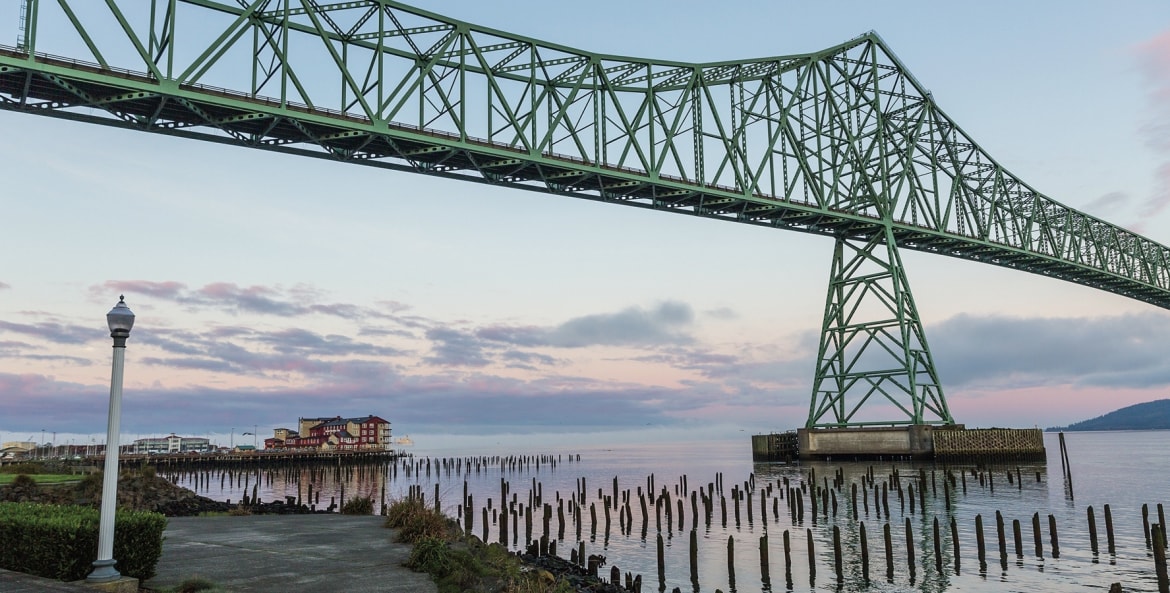Editor’s note: At press time, the United States was still dealing with the Covid-19 pandemic, and some of the attractions mentioned in this story were shut down. As travel restrictions ease and things reopen, please call ahead to confirm the status and hours for any place you plan to visit.
A guy walks into a bar and spies a sea lion under the floor. No joke—it’s right there, maybe 10 feet down. If you visit Buoy Beer Co.’s dockside brewpub and look through the glass set into the floor, you can see the sea lion too, all fat and cranky. Go ahead and gawk: It’s a sea lion under the floor.
Maybe that’s not so strange in Astoria, Oregon, a Columbia River town 95 miles northwest of Portland, where one of the West’s mightiest waterways knuckles into the planet’s largest ocean. Here the wild and the mild, the old and the new, swirl around town like currents in the tide.
Throughout much of the 19th and 20th centuries, Astoria’s waterfront bustled with seafood canneries where workers could clean a 40-pound fish in 45 seconds. Now the cannery buildings house kayak shops, a boutique hotel, and eateries including Buoy Beer. You’ll find the Willapa Bay oysters plump and tangy, but the region’s true flavor sits just beyond the pub’s windows. The water may look placid during your visit, although sailors will tell you that when the weather changes, the sandbank at the river’s mouth known as the Columbia Bar can become a hull-grinding hell of 40-foot waves, dense fog, and shifting shoals.
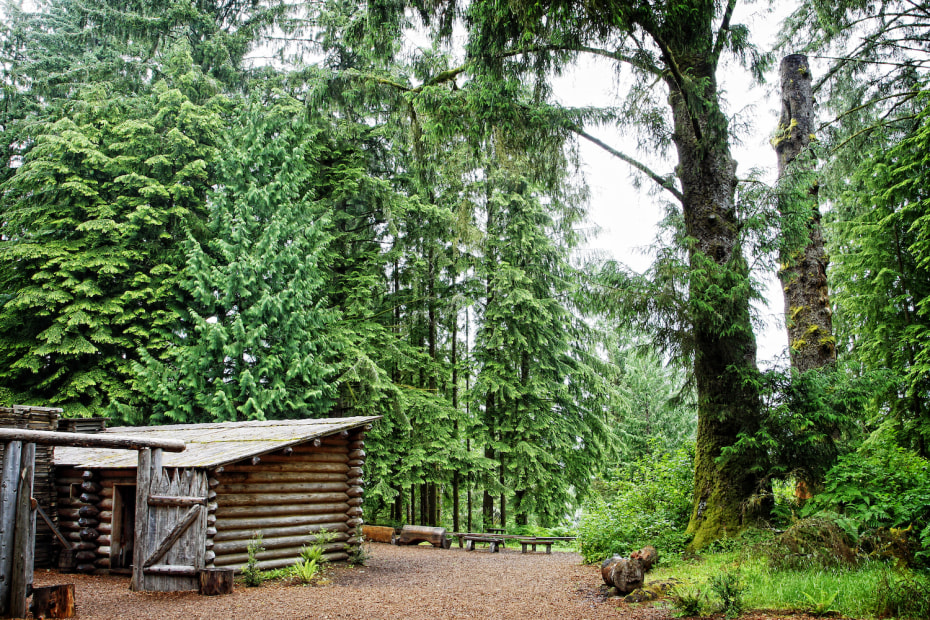
A replica of Lewis and Clark's Fort Clatsop.
Sights and Events
Trading posts and fish canneries lined the Astoria waterfront before Oregon was a state. They’re mostly gone now, but the Astoria Riverwalk has taken their place. From the 6.4-mile walkway, you get sweeping views of the Astoria-Megler Bridge and of hulking cargo ships making their way up and down the river.
Astoria’s riverfront story extends far into the past. In December 1805, the Lewis and Clark Corps of Discovery landed near today’s town and went on to build a modest fort along the Netul River (now the Lewis and Clark River) to the south. They called it Fort Clatsop after the local people and waited out the winter among the hand-hewn palisades.
It was a winter of misery, raining 94 of the 106 days the Corps was there. The explorers’ clothes disintegrated and the chill rattled their bones. “They talked a lot about the fleas keeping them up every night,” says Jill Harding, chief of visitor services at the site, known today as Lewis and Clark National Historical Park. “They were excited to reach the ocean, but they were also ready to leave.”
The fort is tranquil these days. The cedars wear regal capes of bearded lichen, and chipmunks scurry along the paths. The original structures rotted away; replicas were built in 1955—and again in 2006—using a floor plan Clark drew on the elk-skin cover of his journal. You can stick your head into the captain’s quarters, hike 1.3 miles along the ferny South Slough Trail, and download a new audio tour to your smartphone to hear journal readings, music, and stories.
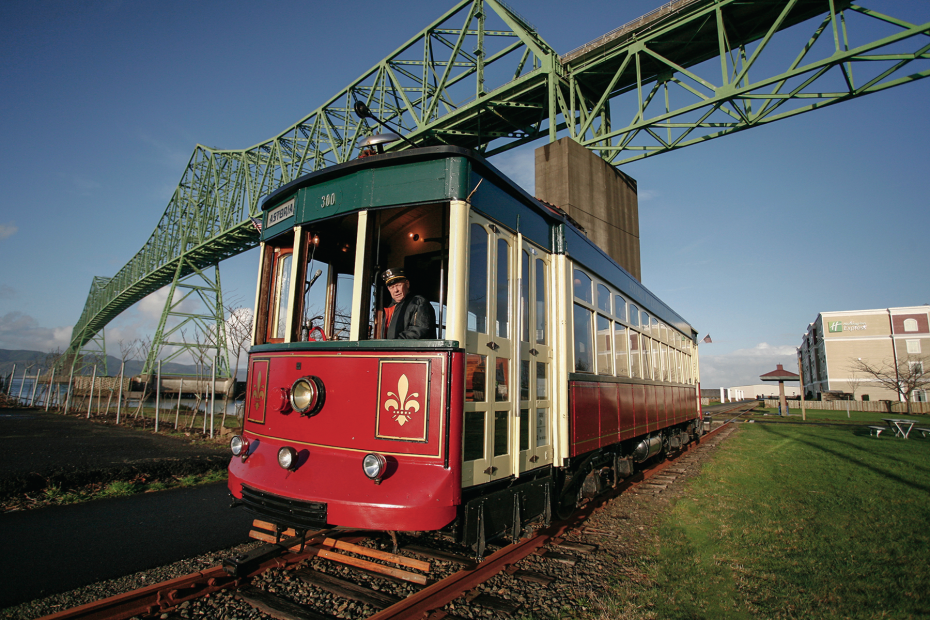
The Old 300 trundles along the Astoria waterfront.
The end of the Lewis and Clark epic set a larger story in motion. By 1811, a mere six years after the Corps’s arrival, a German-born fur merchant named John Jacob Astor sent men to establish a trading post here. It was to become the first United States settlement west of the Rockies, an outpost with doors that swung out toward the Orient and in toward a new nation’s riches. Immigrants from China and Scandinavia came in droves during the 1870s, expanding the economy with logging and fishing when the furs ran out. “Without the immigrants, Astoria would be a very different place,” says Sonja Niemi, a local historian of Finnish descent. “But without the furs we might not have existed at all.”
A legacy of Astoria’s more recent past trundles along the waterfront: A rebuilt 1913 trolley known as Old 300, with curved wooden seats and pleasing lines, makes a 3.5-mile run along the wharf. For $2 you can hop on and off all day, riding past old ferry slips, browsing the Astoria Sunday Market on 12th Street, and gazing up at the underpinnings of the 4.1-mile Astoria-Megler Bridge that soars across the river to Washington. Ask the conductor to point out the orange-and-blue building that was once home to an experimental seafood lab.

A pilot boat at the Columbia River Maritime Museum.
With artifacts that range from early maps of the Pacific Northwest to a decommissioned lightship anchored outside, the Columbia River Maritime Museum offers a deep dive into the history of life on the water. The Crossing the Bar: Perilous Passage exhibit documents the infamous Columbia River bar—one of the many hazards of the north coast. AAA members get $2 off admission.

View vintage labels on canned fish at the Heritage Museum, souvenirs of Astoria’s past.
Step away from the waterfront, cross the highway, and head into downtown Astoria to find another side of history. Set inside a 1904 building that was the town’s first city hall, the Clatsop County Historical Society’s Heritage Museum houses more than 32,000 artifacts and a room-size reconstruction of the Louvre saloon, one of many bygone establishments that catered to mid-19th-century men. You can admire card tables, spin a real roulette wheel, and peruse the bill of fare: smoked goose, Hamburg eel, and Braunschweiger Mettwurst sausage.
Strolling around downtown’s slanted streets brings you closer to the modern era. Local lore says that matinee idol Clark Gable began his acting career performing onstage at Astoria Liberty Hall, at the corner of 12th and Exchange. A commemorative plaque is all that remains of the original venue;.
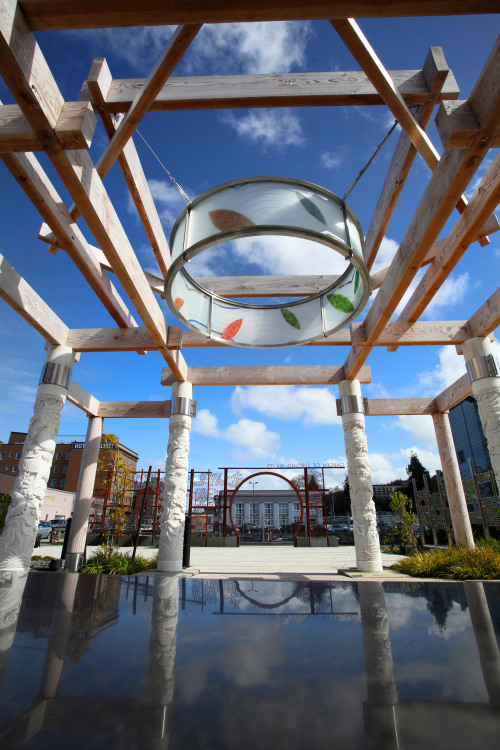
Pergola posts at the Garden of Surging Waves echo Astoria Column’s design.
Head to Heritage Square to admire the Garden of Surging Waves, a sculpture park that celebrates the role Chinese immigrants played in Astoria’s development. Sit on the smooth stone benches with a fish mosaic at your toes, reflecting on the words of the ancestors wrought in iron and stone. One engraving reminds us: “The surging waves of the Long River ride over the ones that have come before, just as new generations are founded on the old.”
Wander up Coxcomb Hill to pay homage to the area’s most famous landmark, the Astoria Column. Built a century before the Surging Waves, the 125-foot tower depicts Astoria’s early days in a frieze spiraling around it. You’ll see the town’s first 100 years unfurl: Lewis and Clark, Mr. Astor, the trappers, the lumbermen, and the fish. Down below on the waterfront awaits the promise of more briny oysters—and a salty sea lion—at the start of a continent and the end of the sea.
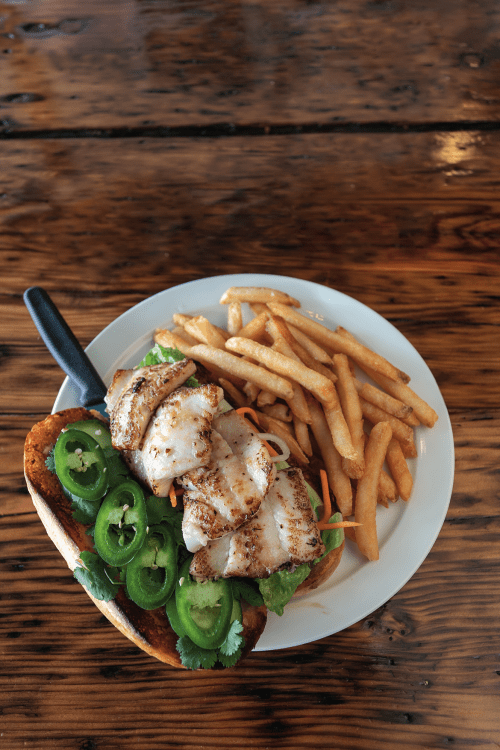
South Bay Wild Fish House's take on a Vietnamese banh mi.
Eats
By day, sunshine filters in through glass blocks. In the evening, a grand fireplace gives the wraparound marble bar a mellow glow. No matter when you visit, Carruthers Restaurant manages to feel both comfy and cool. Popular noshes on the eclectic all-day menu include small plates of gingery Thai brussels sprouts with cashews, and loaded Cajun fries with pork chile verde.
Furnished with historic photos of shipyards and fishing equipment that’s been repurposed as modern art, South Bay Wild Fish House serves local seafood from an open kitchen and takeout market. When you visit, co-owner Rob Seitz might be out on his boat, fishing for petrale sole that will make its way into fish-and-chips, tacos, and a spin on Vietnamese banh mi.
In the heart of downtown, Street 14 Café, a bright bistro on the corner of Commercial and 14th Streets, serves eggs sunny-side up with greens, house-made pastries, and daily quiches. Regulars people-watch from the tall windows or curl up with the local paper as they nurse their oat milk lattes.
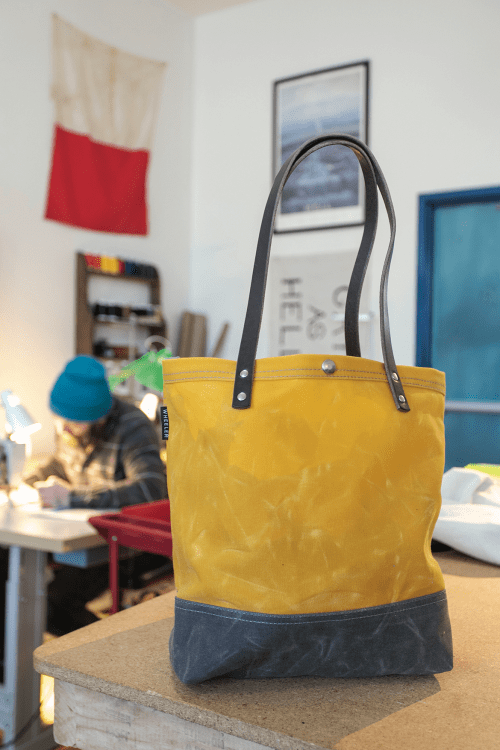
A carryall from Wheeler Bag Co.
Shops
Astoria Vintage Hardware offers 10,000 square feet of antique goods and fittings. One wall holds more than 100 different types of knobs and pulls. Be sure to check out the antique stained glass windows, too, and don’t miss the world’s biggest Operation game—a giant version of the original.
Imogen Gallery showcases large-scale paintings, tiny clay figurines, biomorphic paper lamps, and other works by contemporary artists from the Pacific Northwest. Exhibitions in the narrow yet roomy space change on the second Saturday of every month (to coincide with Astoria’s downtown Art Walk).
It’s the unofficial Astoria uniform: a handmade suspender dress, practical for work or play. Urban fashionistas and regional farmers alike stock up on those, as well as plus-size tunics, aprons, and waxed canvas and leather bags, at Shift and Wheeler Bag Co. The retail space shared by these two vendors is located in a renovated YMCA with an open workroom where shoppers can watch the designers do their thing.
Gaze up at the Gothic spires atop the John Jacob Astor Hotel, where cable television was invented in 1949. Browse for tea and sleeping Buddhas at A Gypsy’s Whimsy, or thumb through banned tomes at Lucy’s Books. Hit up Bach ’n Rock for the Doobie Brothers on eight-track and a visit with the resident parakeets and conures.
